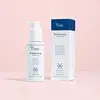What's inside
What's inside
 Key Ingredients
Key Ingredients

 Benefits
Benefits

 Concerns
Concerns

 Ingredients Side-by-side
Ingredients Side-by-side

Water
Skin ConditioningAzelaic Acid
BufferingGlycerin
HumectantPropanediol
SolventGlycereth-26
HumectantAvena Sativa Kernel Flour
AbrasiveCarnosine
Skin ConditioningAcetyl Tetrapeptide-2
Skin ConditioningCeramide NP
Skin ConditioningCeramide EOP
Skin ConditioningCeramide Ns
Skin ConditioningCeramide As
Skin ConditioningCeramide AP
Skin ConditioningGallyl Glucoside
AntioxidantPropyl Gallate
AntioxidantEpigallocatechin Gallatyl Glucoside
AntioxidantDaucus Carota Sativa Root Cell Culture Lysate
Skin ConditioningGossypium Herbaceum Callus Culture
Skin ConditioningSphingomonas Ferment Extract
Skin ConditioningEthylhexylglycerin
Skin ConditioningHydrogenated Lecithin
EmulsifyingSucrose Distearate
EmollientGlyceryl Stearate
EmollientDipropylene Glycol
HumectantDehydroacetic Acid
PreservativeCaprylyl Glycol
EmollientPhenoxyethanol
PreservativeTriethanolamine
BufferingBenzyl Alcohol
PerfumingCitric Acid
BufferingWater, Azelaic Acid, Glycerin, Propanediol, Glycereth-26, Avena Sativa Kernel Flour, Carnosine, Acetyl Tetrapeptide-2, Ceramide NP, Ceramide EOP, Ceramide Ns, Ceramide As, Ceramide AP, Gallyl Glucoside, Propyl Gallate, Epigallocatechin Gallatyl Glucoside, Daucus Carota Sativa Root Cell Culture Lysate, Gossypium Herbaceum Callus Culture, Sphingomonas Ferment Extract, Ethylhexylglycerin, Hydrogenated Lecithin, Sucrose Distearate, Glyceryl Stearate, Dipropylene Glycol, Dehydroacetic Acid, Caprylyl Glycol, Phenoxyethanol, Triethanolamine, Benzyl Alcohol, Citric Acid
Water
Skin ConditioningAzelaic Acid
BufferingGlycerin
HumectantCoco-Caprylate
EmollientPentylene Glycol
Skin ConditioningPotassium Hydroxide
BufferingMethyl Glucose Sesquistearate
EmollientSimmondsia Chinensis Seed Oil
EmollientSqualane
EmollientEthyl Macadamiate
Skin ConditioningCetearyl Alcohol
EmollientPrunus Domestica Seed Oil
Skin ConditioningGlycyrrhiza Glabra Root Extract
Bleaching3-O-Ethyl Ascorbic Acid
Skin ConditioningCamellia Sinensis Leaf Extract
AntimicrobialTocopherol
AntioxidantMandelic Acid
AntimicrobialMalic Acid
BufferingBehenyl Alcohol
EmollientXanthan Gum
EmulsifyingWater, Azelaic Acid, Glycerin, Coco-Caprylate, Pentylene Glycol, Potassium Hydroxide, Methyl Glucose Sesquistearate, Simmondsia Chinensis Seed Oil, Squalane, Ethyl Macadamiate, Cetearyl Alcohol, Prunus Domestica Seed Oil, Glycyrrhiza Glabra Root Extract, 3-O-Ethyl Ascorbic Acid, Camellia Sinensis Leaf Extract, Tocopherol, Mandelic Acid, Malic Acid, Behenyl Alcohol, Xanthan Gum
 Reviews
Reviews

Ingredients Explained
These ingredients are found in both products.
Ingredients higher up in an ingredient list are typically present in a larger amount.
Azelaic acid is a multitasker ingredient that helps treat acne, pigmentation, and irritation. It is a great option for sensitive skin.
What makes azelaic special?
The best thing about azelaic acid is it's gentleness. It's generally well-tolerated and safe to use alongside other actives like niacinamide or salicylic acid.
Unlike AHAs, azelaic acid will not make you photosensitive/sun sensitive.
You can find this ingredient naturally occurring in grains like wheat, rye, and barley. In cosmetics, azelaic acid is typically lab-made, which is more stable and effective.
Learn more about Azelaic AcidGlycerin is already naturally found in your skin. It helps moisturize and protect your skin.
A study from 2016 found glycerin to be more effective as a humectant than AHAs and hyaluronic acid.
As a humectant, it helps the skin stay hydrated by pulling moisture to your skin. The low molecular weight of glycerin allows it to pull moisture into the deeper layers of your skin.
Hydrated skin improves your skin barrier; Your skin barrier helps protect against irritants and bacteria.
Glycerin has also been found to have antimicrobial and antiviral properties. Due to these properties, glycerin is often used in wound and burn treatments.
In cosmetics, glycerin is usually derived from plants such as soybean or palm. However, it can also be sourced from animals, such as tallow or animal fat.
This ingredient is organic, colorless, odorless, and non-toxic.
Glycerin is the name for this ingredient in American English. British English uses Glycerol/Glycerine.
Learn more about GlycerinWater. It's the most common cosmetic ingredient of all. You'll usually see it at the top of ingredient lists, meaning that it makes up the largest part of the product.
So why is it so popular? Water most often acts as a solvent - this means that it helps dissolve other ingredients into the formulation.
You'll also recognize water as that liquid we all need to stay alive. If you see this, drink a glass of water. Stay hydrated!
Learn more about Water